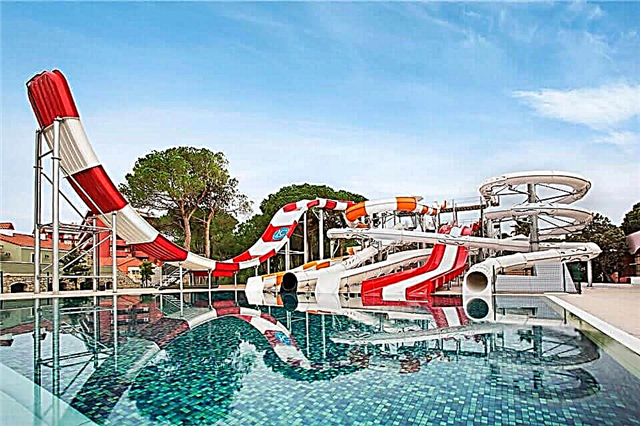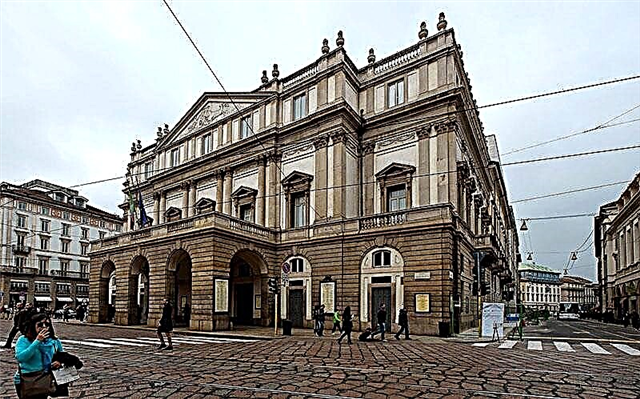One of the most important sights of Milan is the world famous Teatro alla Scala. In appearance, it practically does not differ from most buildings in the city - monumental walls "three windows high", columns, cornices. At the time of construction, there was no area in front of the building, and external elegance was not particularly required. It is now Piazza della Scala that has become an adornment. In the center, immersed in the greenery of trees, framed by flower beds with variegated flowers, there is a monument to Leonardo da Vinci by the famous sculptor Pietro Magni. There are neat benches on the cozy alleys; rest in this place is a great aesthetic pleasure.
The history of La Scala theater

The history of the theater is impressive. In 1778, when it was built according to the project of Giuseppe Piermani, a famous neoclassical architect, Lombardy belonged to the Austrian Empire. Maria Theresa, on whose order this construction began, was characterized by a special attitude towards art.
She then predicted his fate, saying that he would eclipse the glory of the most famous theaters in Italy, and she was absolutely right. La Scala is not just a theater, it is a brand that was created and served by real professionals in their field. This staging style, unchanged over the centuries, has survived from the time when opera from simple entertainment turned into musical drama, became the leading genre of art.
This style is based on the creativity of brilliant artists, directors, musicians ... Even the service personnel are selected very carefully. Decorations, props are created on the territory of the former factory in the workshops "Ansaldo". They play an essential role in La Scala, another feature of the theater. Their naturalness, quality of costumes amaze more than one generation of ardent connoisseurs of theater-goers.

The Italian public has greatly contributed to the formation of the La Scala brand. Capricious and demanding, with exquisite taste, she "brought up" world stars. She lifted great talents to heaven, and threw them off the pedestal for the slightest mistakes. And only geniuses of strong character “survived” on this stage.
Detailed instructions on how to get from the airport to Milan in our life hack
Interior
The huge horseshoe-shaped hall is designed so that the stage is clearly visible from any point on it. It accommodates more than two thousand people, has wonderful acoustic characteristics, they are simply legendary, judging by the myths living under this roof. The building was reconstructed twice. The first - after serious destruction during World War II. The "rebirth" in 1946 did not change him in the least.
And even the renovation in 2004 by the Swiss architect Mario Botta very delicately touched the exterior and interior decoration. The part of the theater, hidden from the public eye, has undergone major changes. The stage has almost tripled, now one can only envy its technical capabilities, which embody almost any production ideas of the director.

Rehearsal rooms have been improved, dressing rooms have become more comfortable. Despite the fact that it was a major overhaul, which brought modern computer technologies into the theater's work, cleaned the interior, the atmosphere looks like a secured antiquity. Marble, gilding, textiles - all this looks as if it has stood here for at least two hundred years and delights in lush luxury.
Milan Cathedral: Terrace Ticket
Milan Cathedral and Terraces by Elevator: Fast Track Ticket
Milan: Sightseeing Bus Tour - 1 Day or 48 Hours
Milan: San Siro Stadium and Museum 1-Hour Inspection Ticket
Serravalle Designer Outlet: Roundtrip Bus from Milan
MilanoCard: Explore Milan Your Way
Dress code

All this chic splendor reflects the solid conservatism traditional for La Scala. Since ancient times, the audience has visited the theater not only for the sake of performance. New outfits, hairstyles, furs and diamonds were shown before the performance by eminent and not so ladies, which, in turn, were boasted by noble gentlemen. Business meetings were held here, small talk was conducted.
The boxes are connected by a corridor where snacks and various drinks were always sold. Many members of the elite spent their time here, and not in the auditorium. The dress code is still practiced these days. In jeans and without a tie, they are simply not allowed here, and women should be in dresses.
Museum
Although you can touch the legend, the La Scala brand, in the museum. History is created by individuals. There are plenty of those in this theater. The passions that have been boiling behind these curtains for more than two hundred years, which continue to boil in our days, give rise to a lot of legends, sometimes even implausible, but always striking the imagination. The exhibits collected here tell about the events associated with the greatest triumphs and ordinary performances of the most gifted artists.
From the museum there is an exit to the hall, where curious sightseers can see the famous scene. At a small table in the theater cafe, one can feel the atmosphere in which ideas for the next masterpiece have been discussed thousands of times.
How to get there
The theater is located at Via Filodrammatici, 2. If you are walking in the square in front of the Duomo, you only need to go through Galleria Vittorio Emanuele II. This way you can go straight to the opera house.
If you are taking the metro, you can get off at any station: Duomo, Montenapoleone or Cordusio. Each of them is at the same distance from the place you want.
Are you planning to take a tram? Then you need transport following the route no. 1 or 2. Get off at the stop Manzoni Scala or S. Margherita Scala.
Working hours
Daytime concerts start at 2:00 pm, 2:30 pm, 3:00 pm and 4:00 pm, with evening concerts at 6:00 pm, 7:00 pm and 8:00 pm. The theater museum is open daily from 9 am to 5:30 pm. There is a one hour break from 12:30. Days off: 7.12, 24-26 December, 31.12, 1 January, Easter, 01.05 and 15 August. The cost of a ticket to the museum for an adult is 7 euros. Children under 12 years old are admitted free.
The cost of tickets to La Scala
Ticket prices vary considerably. The lowest cost of a ticket to the opera is 11 euros, the highest is 2000. The cost of ballet tickets starts at 5 euros and the upper threshold is 250 euros. The cheapest concert ticket starts at 5 euros, the most expensive will cost 40 euros. Symphony orchestra tickets range from 6.5 to 85 euros.
You can buy tickets on the theater's official website - teatroallascala.org. If you are interested in a specific date, we recommend that you take care of the purchase in advance, and closely follow the start of sales. Please note there is a fee for online bookings. The fact is that resellers know their business and make good money on tourists. If you didn't manage to get the coveted ticket, come to the theater on the day of the concert a few hours in advance. Of course, there will be a lot of people who want to buy a ticket, so don't yawn.

You will see a man with a dog, run to him, perhaps now he is no longer working, but a couple of years ago all "bearded" travelers wrote about him not only from Russia, but also from other countries. It is from him that you can buy what you need at a price that includes a fairly tolerable commission.
Teatro alla Scala on the map
La Scala photo

















